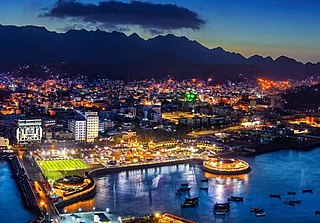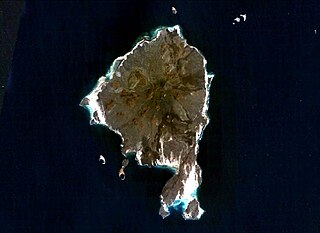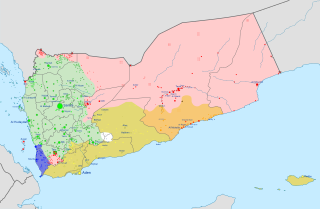| Aaragah | |
|---|---|
| Location | |
| Country | Yemen |
| Physical characteristics | |
| Mouth | |
• coordinates | 13°57′58″N46°07′53″E / 13.96611°N 46.13139°E |
Aaragah is a wadi (river) of Yemen. It flows through the Abyan Governorate. [1] It flows through the town of Al Qaws.
| Aaragah | |
|---|---|
| Location | |
| Country | Yemen |
| Physical characteristics | |
| Mouth | |
• coordinates | 13°57′58″N46°07′53″E / 13.96611°N 46.13139°E |
Aaragah is a wadi (river) of Yemen. It flows through the Abyan Governorate. [1] It flows through the town of Al Qaws.

The economy of Yemen has significantly weakened since the breakout of the Yemeni Civil War and the humanitarian crisis, which has caused instability, escalating hostilities, and flooding in the region. At the time of unification, South Yemen and North Yemen had vastly different but equally struggling underdeveloped economic systems. Since unification, the economy has been forced to sustain the consequences of Yemen's support for Iraq during the 1990–91 Persian Gulf War: Saudi Arabia expelled almost 1 million Yemeni workers, and both Saudi Arabia and Kuwait significantly reduced economic aid to Yemen. The 1994 civil war further drained Yemen's economy. As a consequence, Yemen has relied heavily on aid from multilateral agencies to sustain its economy for the past 24 years. In return, it has pledged to implement significant economic reforms. In 1997 the International Monetary Fund (IMF) approved two programs to increase Yemen's credit significantly: the enhanced structural adjustment facility and the extended funding facility (EFF). In the ensuing years, Yemen's government attempted to implement recommended reforms: reducing the civil service payroll, eliminating diesel and other subsidies, lowering defense spending, introducing a general sales tax, and privatizing state-run industries. However, limited progress led the IMF to suspend funding between 1999 and 2001.

The Bab-el-Mandeb, the Gate of Grief or the Gate of Tears, is a strait between Yemen on the Arabian Peninsula and Djibouti and Eritrea in the Horn of Africa. It connects the Red Sea to the Gulf of Aden and by extension the Indian Ocean.

Yemen, officially the Republic of Yemen, is a country in West Asia. Located in southern Arabia, it borders Saudi Arabia to the north, Oman to the northeast, the Red Sea to the west, and the Indian Ocean to the south, sharing maritime borders with Eritrea, Djibouti and Somalia across the Horn of Africa. Covering roughly 528,000 square kilometres, with a coastline of approximately 2,000 kilometres, Yemen is the second largest country on the Arabian Peninsula. Sanaa is its constitutional capital and largest city. Yemen's estimated population is 34.7 million, mostly Arab Muslims. It is a member of the Arab League, the United Nations, the Non-Aligned Movement and the Organisation of Islamic Cooperation.
The UN Yemen Observation Mission (UNYOM) was established in 1963.

Zuqar Island is an island in the Red Sea that belongs to Yemen. It lies between the coasts of mainland Yemen and Eritrea, near the Bab-el-Mandeb straits which connect the Red Sea to the Gulf of Aden. Despite its proximity to the African continent, Zuqar Island is considered a part of Asia because it sits on the Asian continental shelf. It is appropriately 130 square kilometres (50 sq mi).

The cinema of Yemen is relatively obscure, but it has seen glimpses of influence and representation throughout the years. Since the 1920s, when expeditions from Europe arrived in Yemen, the country has been featured in various documentaries and travelogues. These early films introduced audiences to the landscapes, architecture, and culture of Yemen, providing a window into a world they might not have otherwise experienced.

Yemen has only competed at the Summer Olympic Games, sending athletes to every edition since its first participation in 1992. Before the Yemeni unification in 1990, Yemenite athletes had competed at the Games as early as 1984, representing North Yemen or South Yemen. Yemen has not yet won any Olympic medal.

Pakistan and Yemen enjoy excellent relations as both share bonds of religion, culture and values. Relations date back when both nations were part of trading routes of ancient times. Parts of the land that now constitutes Pakistan and the territory of Yemen were part of the Persian Empire, and later of Umayyad and Abbasid Caliphates. Yemen has a spiritual role in history of Pakistan. Zaydi school of Yemen produced a soldier Abdullah Ashtar who was a patrilineal descendant of the Islamic prophet Muhammad through the Hasani branch. He was killed by Abbasid dynasty and he is buried in Karachi, Pakistan. He is famous as a Sufi saint in Pakistan. Both countries seek to further boost bilateral ties and cooperation, and Yemen has confirmed Pakistan is in support of resolving the crisis through means of dialogue.

Qishr is a Yemeni traditional hot drink made of spiced coffee husks, ginger, and sometimes cinnamon. In Yemen, it is usually drunk as an alternative to coffee because it doesn't need to be roasted.

The Wadi Bana is a major wadi of southwestern Yemen. It flows from the mountains through the Abyan Governorate and eventually enters the Gulf of Aden in between the towns of Al Kawd and the regional capital of Zinjibar. The wadi reportedly receives the most rainfall in the entire country, which accounts for the agricultural lands which have grown up near its mouth in an otherwise barren country. Its mouth is located at 13°03′52″N45°23′10″E.

The European Union and Yemen enjoy longstanding relations, which date back to 1997 when the first official cooperation agreement was signed. This relationship has kept growing ever since. In December 2009, the EU established a full diplomatic representation to the Republic of Yemen. Many EU Member States enjoy strong and historical relations with Yemen that date back to the 1930s. The United Kingdom, France, Germany and the Netherlands are among Yemen's main donors; France has far ranging economic relations while Italy was the first state to open diplomatic relations with Yemen. Seven Member States are represented in Sana’a: Bulgaria, France, Germany, Italy, Netherlands, Spain and the United Kingdom.
The Harras of Dhamar is a volcanic field in Yemen.

Russia and Yemen enjoy both warm and friendly relations that goes back to more than a century. Russia has supported both the Yemen Arab Republic and the People's Democratic Republic of Yemen on several occasions and established close relations with them. After Yemeni unification, both countries maintain close ties.

Indonesia–Yemen relations are current and historical bilateral relations between Indonesia and Yemen since 21 April 1962. Indonesia and Yemen shared similarity as the Muslim majority countries, Indonesia is the most populous Muslim country in the world, while Yemen is also a Muslim majority nation. Indonesia has an embassy in Sana'a, while Yemen has an embassy in Jakarta. Both the countries have many cultural proximities and similar view on international issues and these nations are members of the Non-Aligned Movement, Indian-Ocean Rim Association and Organisation of Islamic Cooperation (OIC).

Bilateral relations exist between the Kingdom of Bahrain of and the Republic of Yemen. Both Bahrain and Yemen were part of the Persian Empire, and later the Umayyad and Abbasid caliphates. Yemen has an embassy in Manama. Bahrain has an embassy in Sana'a.

On 26 March 2015, Saudi Arabia, leading a coalition of nine countries from West Asia and North Africa, launched an intervention in Yemen at the request of Yemeni president Abdrabbuh Mansur Hadi, who had been ousted from the capital, Sanaa, in September 2014 by Houthi insurgents during the Yemeni Civil War. Efforts by the United Nations to facilitate a power sharing arrangement under a new transitional government collapsed, leading to escalating conflict between government forces, Houthi rebels, and other armed groups, which culminated in Hadi fleeing to Saudi Arabia shortly before it began military operations in the country.

The geology of Yemen includes extremely ancient Precambrian igneous and metamorphic crystalline basement rocks overlain by sediments from the Paleozoic, Mesozoic and Cenozoic, deposited in shallow seas and lakebeds, overlain by thick volcanic rocks and loess. Erosion has played a major role in Yemen's geologic history and eliminated many rock units over time.
The South Yemeni Football League or the People's Democratic Republic of Yemen Football League was an association football league held for domestic football clubs in South Yemen held between 1970 and 1990. The league was folded when South and North Yemen unified as one country (Yemen) on 22 May 1990. This resulted in the creation of the Yemeni League.
The Well of Barhout is a sink hole in Al-Mahara, Yemen. It has a circular entrance that measures about 30 m (100 ft) wide at the surface, and it is 112 metres (367 ft) deep.
On 24 September 2015, a double suicide bombing was carried out by Islamic State at a mosque in Sana'a, Yemen, killing at least 25 people.